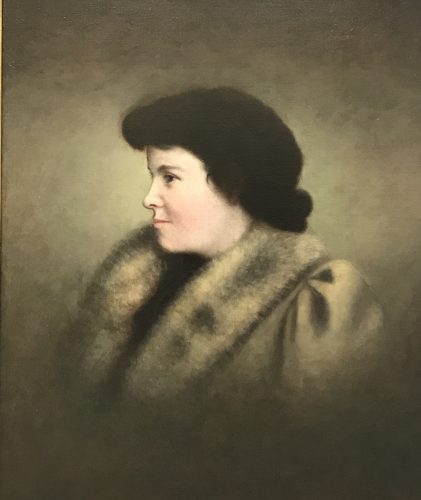This article is more than 5 years old.
Imagine yourself as a young well-off white woman in the mid-19th century and try to envision the limited educational opportunities that would have been available for women in your positions at that time, even you. Next, note that in 1883 – yes, 1883 – Wake Forest accepted the first female student to the ranks of the small all-men Baptist college. It’s a known fact this leap to co-education happened when it did, but little is known of the brave young woman, Eva Belle Simmons, who first walked the halls of Wake Forest College. And what brought her to the male dominated school of higher learning at a time when such opportunities were quite rare for women?

To unravel the story of this trailblazer, one has to look back into the history of a prominent North Carolina family. The Simmons Family originated in Montgomery County, NC, just south of Guilford and Randolph counties today. The family patriarch, Mr. Lockey Simmons, was known as “a fool for education”, and he also had a role in the 1834 founding of Wake Forest College. Lockey was “a man distinguished for his industry, wealth, and interest in his denomination and education,” according to one biographer. Lockey and his wife, Mary L. Pennington, had six children, one being William Gaston Simmons, who left Montgomery County in 1849 at age 19 to enter Wake Forest College. Simmons graduated top of his class in 1852 and then attended the University of North Carolina at Chapel Hill to study law. William Gaston Simmons married Mary Elizabeth Foote on September 1, 1853. In 1855, he was elected Professor of Mathematics for his alma mater at Wake Forest so he left his career as an attorney, and William and Mary Elizabeth moved to the school’s campus in Wake Forest, NC.
By 1863, the Civil War caused the closing of the College but the Simmons family continued living in the town of Wake Forest. The Simmons were instrumental in keeping “the educational torch burning during the dark and trying hours of the (Civil) War and Reconstruction,” and it was Mary Elizabeth and William Simmons who “rendered essential and sacrificial service” in the re-opening of the College in 1866.
On October 2, 1868, the Simmons’s seventh child, Eva Belle (also written as Evabelle), was born and her path toward a higher level of education was most likely paved early in her life. With her father holding many roles at Wake Forest – from first Head of the Natural Sciences Department, first Curator of the Library, Head of the School of Physics and Applied Mathematics, and College Treasurer and Bursar – and her mother, Mary Elizabeth, an advocate for the 14 male students boarding in her home and otherwise working diligently for the welfare of the college, it was only a matter of time before Eva Belle would have her sights set on attending Wake Forest.
Eva Belle watched her older brother, Thomas Jackson Simmons, graduate from Wake Forest in 1883, but she also knew Wake Forest held a strict policy forbidding the education of women. Eva Belle also would have known the exception to the strict rule: women who lived in the town of Wake Forest could take classes with a male family member if permission was granted by the College Trustees. It was the Simmons family’s multi-generational devotion and service to Wake Forest College that allowed Eva Belle Simmons entry. It was 1883, at the age of 14, Eva Belle enrolled at Wake Forest along with her brother, James Henry Simmons. Wherever Henry went on campus, Eva Belle followed, and surprisingly, she was allowed to participate in class recitations, she had her poetry published in The Student, and she became the first female member of the Philomathesian Society.

In 1888, all of her classmates, including her brother, James Henry were granted a diploma. Although Eva Belle had completed her four years of required work and had finished with highest academic honors, the Board of Trustees “obstinately refused to grant her the lettered recognition of her labor.” In opposition to the Board’s actions, Eva Belle’s male classmates refused to walk across the stage to accept their diplomas if Eva Belle was not to receive the recognition she duly deserved.
Two years later on June 12, 1890, the College Board of Trustees passed a resolution stating “on the recommendation of the faculty, the degree of B.A. is conferred upon Miss Eva Belle Simmons.” After receiving her diploma, Eva Belle continued writing and publishing poetry as well as serving as a teacher and principal at the Wake Forest Academy. She then accepted a teaching position at Union Female Academy in Eufaula, Alabama, where her brother Thomas Simmons taught. She remained in this role until her sudden and untimely death in March 1898 at 29 years old. Following her death, it was written in the Wake Forest Student (April 1898) Eva Belle possessed “the genuine teacher’s heart – kind, simple, pure and sympathetic.”
Eva Belle was buried in the Wake Forest Cemetery alongside those in her family that made it possible for her to become Wake Forest’s first female graduate. In 1890, The Alumni News wrote, “Wake Forest has many sons, but only one daughter” and Eva Belle Simmons remained that singular daughter until 1942 when the College began admitting white women during World War II; the first Black women arrived on campus in the fall of 1969.

5 Comments on ‘Wake Forest’s “First Daughter”’
This is such an interesting article on WFU’s first female graduate! It was inspiring to read the history of Eva Belle breaking this barrier.
Thanks, Nancy, what a truly fascinating post about Eva Belle!
I learned a lot from this — thank you for researching and writing it.
I have looked at the portrait a million times, but never knew so much about her! Thanks, Nancy, for this wonderful peek into her life at Wake Forest College.
A very important part of history and an excellent and well written article! Well done Mrs. Sullivan!